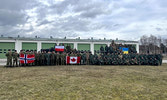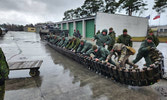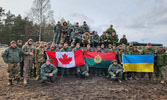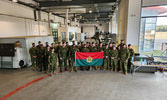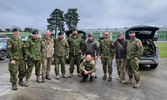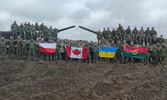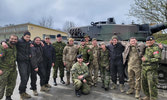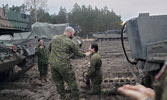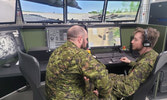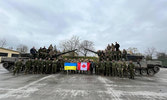Op UNIFIER – Leopard Training Element
By: Capt Philip German and Lt Liam Misner
With the Russian invasion of Ukraine having been underway for over a year, members of LdSH(RC) have been chomping at the bit, hoping for some way to apply their experience gained from years of preparing to fight against Soviet-pattern equipment and tactics. In early February of 2023, members of A Sqn finally got their chance in the form of the Op UNIFIER Leopard Training Element (LTE). This was a multinational mission to train Ukrainian tankers to become proficient in the use of the Leopard 2A4 Main Battle Tank. On short notice, 1st Troop (Tp), A Squadron (Sqn) was surged out to the 10th Armoured Cavalry Brigade in Świętoszów, Poland to begin training Ukrainian crews of experienced T-series tankers on their new platform.
Within 12 hours of the LTE main body’s arrival, instruction began. The soldiers of the Armed Forces of Ukraine (AFU) were split between Canadian, Polish, and Norwegian training teams, with each nation allotted 7 AFU crews. The Canadian training team was composed mainly of A Sqn personnel. Capt Brittney Shki-Giizis led the Canadian contingent as the 1st Tp leader and LTE Commander, WO Colin Davidson as LTE Sergeant-Major, Capt Philip German as Liaison Officer, and numerous Senior NCOs, MCpls, and Cpls. Each member of the team was an expert in their crew position, or several, adding to the team’s overall depth of experience and knowledge; their hard work was invaluable to the mission.
The courses were 30 days in length and walked the crews through everything that they needed to know for their respective crew positions. Classes started with basic drills and component identification. Overall, the training plans seemed simple but were complicated by the initial lack of linguist support due to the speed in which the training teams were established. Once the linguists arrived, communication between instructors and their AFU counterparts greatly improved; the challenges, however, did not stop there. Instructors found that teaching such precise and technical content through the translators – civilians and therefore not experts in tanks or armour – was itself a valuable skill that had to be learned and perfected over time. The course then moved to gunnery and driving/maintenance skills, enabled by the wide variety of simulators and training aids made available to the LTE. The Polish Tank School provided their advanced driver and gunnery simulators, laser supported turret cut-out ranges, and use of their Leopard 2A4s and 2PLs. The Norwegians brought some of their toys as well, providing their highly flexible laptop-based gunnery simulators complete with emulated Leopard 2 gunner controls. As the AFU students became more confident, the course moved to bore-sighting, zeroing, and some collective training before culminating in live ranges and troop-level dry training. On completion, graduates returned to Ukraine ready to use their new skills and tanks in defence of their homeland.
At the time of writing, the LTE has trained two serials of Ukrainian tankers. The first serial was composed of seasoned soldiers with battlefield experience on T-series platforms. This battle experience posed some challenges in learning the characteristics of the Leopard 2A4 and the tactical opportunities the platform enables, such as a reverse gear that dramatically exceeds the 4 km/h of the older T-series tanks. Teaching is, however, truly a two-way street. While we taught them about the technical abilities of the Leopards, the battle tested AFU crews also taught us a great deal about fighting the Russians from their own real-world experience. Our soldiers learned about AFU tank tactics and their tank-on-tank experiences extensively. One such lesson, for example, taught us the utility of using tanks in an indirect role corrected by drones to mitigate the danger of return fire from ATGMs and other tanks. The second serial was composed of younger soldiers. Although they were less experienced, they were all very highly motivated to learn new skills and had an increased technical savviness. The second iteration of the course ran similarly to the first but benefitted from all the lessons learned pooled between the three nations’ training teams during the execution of the initial serial.
On completion of the second serial of training, the first rotation of the LTE was able to return home after being replaced by a second wave of members from A Sqn and several augmentees from the other squadrons of LdSH(RC). With the start date for the third serial approaching, we practice instructor training and continue translating courseware to ensure that, when we are called to instruct subsequent serials, we will be ready. After all, our companions fighting in Ukraine deserve no less.

